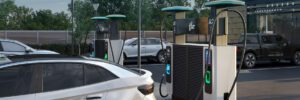If you’re looking to buy a brand new EV and you want the one that charges the quickest, this post is for you.
Source: Electric Vehicle News
2025 Mercedes-Benz GLC Plug-In Hybrid Lands In The U.S.
The most popular Mercedes-Benz car in the U.S. gets an electrified addition as PHEVs gain traction.
Source: Electric Vehicle News
FLO debuts EZLift EV charging cable system for easier extension and retraction
Canada-headquartered FLO, an EV charging station manufacturer and network operator, has introduced its new motorized cable management system, EZLift.
The system will be offered on the company’s new FLO Ultra fast charger. It is designed to reduce stress on drivers by automating extension and retraction of cables that can weigh more than 25 pounds.
Housed in the charger’s sealed canopies, the system locks into place while charging, and sensors initiate the automatic retraction and return of the cable to the station after charging.
“Drivers have told us fast charger cables can be bulky and difficult to maneuver,” said FLO Chief Product Officer Nathan Yang. “The FLO Ultra is a fast charger for all drivers, which drove us to prioritize accessibility in the development of the EZLift cable management system. This system enables users from a wider range of ages, strengths and sizes to manage heavy fast charging cables more easily.”
Source: FLO
Source: Electric Vehicles Magazine
Phoenix Motorcars and InductEV collaborate on wireless EV charging
Phoenix Motor, a manufacturer of electric transit buses and commercial EVs, has partnered with wireless charging pioneer InductEV (formerly Momentum Dynamics). The companies will develop software, hardware and cooling and electrical systems to integrate InductEV’s wireless charging pads with Phoenix’s electric drive systems.
This strategic partnership will provide Phoenix’s customers with the option to select wireless inductive charging.
As execs from the company then called Momentum Dynamics explained to Charged in a 2022 interview, wireless charging is not just about convenience—implemented properly, it can unlock significant cost savings by enabling fleet operators to run routes with smaller batteries and fewer charging stations, and extending battery life.
“Wireless charging is well-suited for fixed route applications such as airports, seaports, hotels, and municipal and school bus markets,” said Phoenix CEO Denton Peng. “InductEV’s modular platform and small footprint allow Phoenix to successfully adopt InductEV’s technology on our medium-duty vehicles and offer our customers a cleaner and more versatile charging solution.”
Phoenix has already accepted orders for wireless charging of its Class 4 shuttles and expects to deploy its first wireless charging-capable shuttle buses later in 2024.
“We’re delighted to partner with a well-regarded industry OEM like Phoenix,” said M. David Dealy, President and Chief Commercial Officer, InductEV. “The use cases for Phoenix’s medium-duty vehicles align perfectly with InductEV’s wireless charging approach to the commercial transport market.”
Source: InductEV
Source: Electric Vehicles Magazine
Reed Relays for Electric Vehicle and Charge Point Testing: Download the application guide
Pickering’s EV & Charge Point Testing application guide explains why high-isolation reed relays are a viable solution for instrumentation & test equipment intended for measuring high voltages & verifying the integrity of electrical insulation on electric vehicles & charging points.
Full contents of the guide:
- High Voltage & Insulation Resistance Testing
- Comparing Switching Technologies
- Reed Relay Terminology
- Recommended Products
- Why Pickering for Reed Relays?
Source: Electric Vehicles Magazine
Xiaomi's New EV Will Let You Add Physical Buttons Below Its Touch Screen
The SU7 comes from the factory with an all-touch interface, but you can install buttons yourself.
Source: Electric Vehicle News
Ferrari CEO: ‘Our EV Will Not Be Silent’
An all-electric prancing horse is expected to launch in the final quarter of 2025.
Source: Electric Vehicle News
EVs reach 90% market share in Norway as the overall auto market falters
The days of ICE vehicles in Norway are numbered. Some years ago, the government set a goal of 100% electric sales by 2025, and that goal is well within sight. In the month of February, plug-in vehicles took 92.1% of the market, up from 90.1% year-on-year. Battery EVs took a 90% share, as recent tax changes make PHEVs less appealing.
Volkswagen sold its last gas-powered car in Norway last December, and it seems likely that other brands will follow.
Tesla’s Model Y was by far the best-selling vehicle—it sold 1,749 units, 23.7% of the entire auto market. Its sales were about equal to those of the next 7 models combined. Joining Model Y on the podium were the Toyota bZ4x and Volkswagen ID.4, followed by the new Volvo EX30, and two old favorites, the Nissan LEAF and Hyundai Kona.
The steady rise of EVs is occurring against a backdrop of slower overall auto sales. A total of 7,380 cars sold in Norway in February, a decrease from last February. The trade group OFV (Norwegian Road Federation) ascribes the ailing auto market to weakness in the broader economy—interest rates are up, and so are prices for food and electricity.
However, CleanTechnica identifies another possible culprit: stubbornly high prices for EVs. Legacy vehicles are subject to heavy taxes, but there are few affordable electric models. The cheapest BEV CleanTechnica found on offer was the 39 kWh Nissan LEAF, which starts at 232,600 Norwegian kroner (about $22,000). For better or for worse, a lack of low-priced options seems likely to result in declining overall auto sales.
The lack of affordable EVs is an issue everywhere in Europe, and in the US. Auto buyers in China and India (and increasingly, smaller emerging auto markets) have more cheap entry-level models to choose from. Western automakers, following Tesla’s lead, have chosen to electrify their high-end models first, and Chinese companies are eagerly filling the vacuum, ramping up exports of low-priced EVs (and ICEs).
Yes, Chinese EVs can be seen on the streets of Oslo and other Norwegian cities, but of the models currently on offer, only the MG4 cracked Norway’s top 10 in February. However, the super-cheap BYD Dolphin made its Norwegian debut last month, and others are on the way, so følg med!
Source: OFV via CleanTechnica
Source: Electric Vehicles Magazine
The Audi Q6 E-Tron May Also Have To Be Built In America To Satisfy Demand
Plus, Stellantis strikes a deal with California it once fought against, and Germany’s lefties and right-wingers are equally mad at Tesla.
Source: Electric Vehicle News
Tesla Cybertruck Has The 'Worst Panel Gap' MKBHD Has Ever Seen
Musk later confirmed that 15 Cybertrucks have been in service due to a gap caused by an improperly torqued door striker.
Source: Electric Vehicle News




